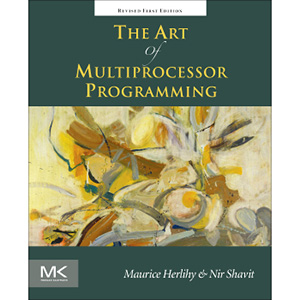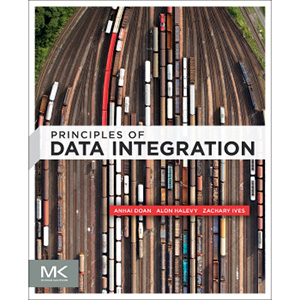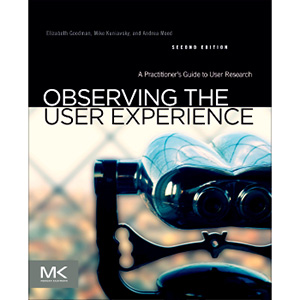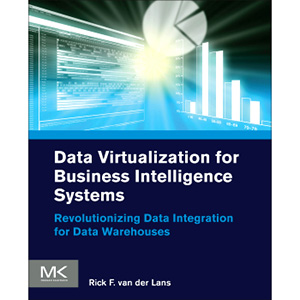| The Art of Multiprocessor Programming, Revised Reprint Posted: 20 May 2013 11:00 AM PDT 
Book Description Revised and updated with improvements conceived in parallel programming courses, The Art of Multiprocessor Programming is an authoritative guide to multicore programming. It introduces a higher level set of software development skills than that needed for efficient single-core programming. This book provides comprehensive coverage of the new principles, algorithms, and tools necessary for effective multiprocessor programming. Students and professionals alike will benefit from thorough coverage of key multiprocessor programming issues. - This revised edition incorporates much-demanded updates throughout the book, based on feedback and corrections reported from classrooms since 2008
- Learn the fundamentals of programming multiple threads accessing shared memory
- Explore mainstream concurrent data structures and the key elements of their design, as well as synchronization techniques from simple locks to transactional memory systems
- Visit the companion site and download source code, example Java programs, and materials to support and enhance the learning experience
Table of Contents
Chapter 1. Introduction
Chapter 2. Mutual Exclusion
Chapter 3. Concurrent Objects and Linearization
Chapter 4. Foundations of Shared Memory
Chapter 5. The Relative Power of Synchronization Methods
Chapter 6. The Universality of Consensus
Chapter 7. Spin Locks and Contention
Chapter 8. Monitors and Blocking Synchronization
Chapter 9. Linked Lists: the Role of Locking
Chapter 10. Concurrent Queues and the ABA Problem
Chapter 11. Concurrent Stacks and Elimination
Chapter 12. Counting, Sorting and Distributed Coordination
Chapter 13. Concurrent Hashing and Natural Parallelism
Chapter 14. Skiplists and Balanced Search
Chapter 15. Priority Queues
Chapter 16. Futures, Scheduling and Work Distribution
Chapter 17. Barriers
Chapter 18. Transactional Memory Book Details - Paperback: 536 pages
- Publisher: Morgan Kaufmann (May 2012)
- Language: English
- ISBN-10: 0123973376
- ISBN-13: 978-0123973375
Note: There is a file embedded within this post, please visit this post to download the file. Related Books The post The Art of Multiprocessor Programming, Revised Reprint appeared first on Wow! eBook. |
| Principles of Data Integration Posted: 20 May 2013 10:56 AM PDT 
Book Description How do you approach answering queries when your data is stored in multiple databases that were designed independently by different people? This is first comprehensive book on data integration and is written by three of the most respected experts in the field. This book provides an extensive introduction to the theory and concepts underlying today’s data integration techniques, with detailed, instruction for their application using concrete examples throughout to explain the concepts. Data integration is the problem of answering queries that span multiple data sources (e.g., databases, web pages). Data integration problems surface in multiple contexts, including enterprise information integration, query processing on the Web, coordination between government agencies and collaboration between scientists. In some cases, data integration is the key bottleneck to making progress in a field. The authors provide a working knowledge of data integration concepts and techniques, giving you the tools you need to develop a complete and concise package of algorithms and applications. - Offers a range of data integration solutions enabling you to focus on what is most relevant to the problem at hand.
- Enables you to build your own algorithms and implement your own data integration applications
- Companion website with numerous project-based exercises and solutions and slides. Links to commercially available software allowing readers to build their own algorithms and implement their own data integration applications. Facebook page for reader input during and after publication.
Table of Contents
Chapter 1. Introduction Part I: Foundational Data Integration Techniques
Chapter 2. Manipulating Query Expressions
Chapter 3. Describing Data Sources
Chapter 4. String Matching
Chapter 5. Schema Matching and Mapping
Chapter 6. General Schema Manipulation Operators
Chapter 7. Data Matching
Chapter 8. Query Processing
Chapter 9. Wrappers
Chapter 10. Data Warehousing and Caching Part II: Integration with Extended Data Representations
Chapter 11. XML
Chapter 12. Ontologies and Knowledge Representation
Chapter 13. Incorporating Uncertainty into Data Integration
Chapter 14. Data Provenance Part III: Novel Integration Architectures
Chapter 15. Data Integration on the Web
Chapter 16. Keyword Search: Integration on Demand
Chapter 17. Peer-to-Peer Integration
Chapter 18. Integration in Support of Collaboration
Chapter 19. The Future of Data Integration Book Details - Hardcover: 520 pages
- Publisher: Morgan Kaufmann (June 2012)
- Language: English
- ISBN-10: 0124160441
- ISBN-13: 978-0124160446
Note: There is a file embedded within this post, please visit this post to download the file. Related Books The post Principles of Data Integration appeared first on Wow! eBook. |
| Observing the User Experience, 2nd Edition Posted: 20 May 2013 10:53 AM PDT 
Book Description The gap between who designers and developers imagine their users are, and who those users really are can be the biggest problem with product development. Observing the User Experience will help you bridge that gap to understand what your users want and need from your product, and whether they’ll be able to use what you’ve created. Filled with real-world experience and a wealth of practical information, this book presents a complete toolbox of techniques to help designers and developers see through the eyes of their users. It provides in-depth coverage of 13 user experience research techniques that will provide a basis for developing better products, whether they’re Web, software or mobile based. In addition, it’s written with an understanding of product development in the real world, taking tight budgets, short schedules, and existing processes into account. Since the publication of the first edition, the business of user research has exploded with new technologies and new techniques. This second edition takes those changes into account with extensive revisions to existing topics. It also adds entirely new material on observational research, mobile usability, diary studies, remote research, and cross-cultural and multilingual projects. - Explains how to balance usability with creativity and originality
- A valuable resource for designers, developers, project managers — anyone whose work affects the end user experience
- Provides a real-world perspective on research. Helps you do user research cheaply and quickly, and present it persuasively
- Gives you the tools and confidence to perform user research on your own design, tuning user experience to the unique needs of your product and its users
Table of Contents
Part I: Why Research is Good and How It Fits Into Product Development
Chapter 1. Introduction
Chapter 2. Do a Usability Test Now!
Chapter 3. Balancing Needs Through Iterative Development Part II: User Experience Research Techniques
Chapter 4. The Research Planning
Chapter 5. Competitive Research
Chapter 6. Universal Tools: Recruiting and Interviewing
Chapter 7. Focus Groups
Chapter 8. More Than Words: Object-Based Techniques
Chapter 9. Field Visits: Learning from Observation
Chapter 10. Diary Studies
Chapter 11. Usability Tests
Chapter 12. Surveys
Chapter 13. Global and Cross-Cultural Research
Chapter 14. Others’ Hard Work: Published Information and Consultants
Chapter 15. Analyzing Qualitative Data
Chapter 16. Automatically Gathered Information: Usage Data and Customer Feedback Part III: Communicating Results
Chapter 17. Research into Action: Representing Insights as Deliverables
Chapter 18. Reports, Presentations, and Workshops
Chapter 19. Creating a User-Centered Corporate Culture Appendices
Appendix A. The Budget Research Lab
Appendix B. Common Survey Questions
Appendix C. Observer Instructions Book Details - Paperback: 608 pages
- Publisher: Morgan Kaufmann; 2nd Edition (September 2012)
- Language: English
- ISBN-10: 0123848695
- ISBN-13: 978-0123848697
Note: There is a file embedded within this post, please visit this post to download the file. Related Books The post Observing the User Experience, 2nd Edition appeared first on Wow! eBook. |
| Letting Go of the Words, 2nd Edition Posted: 20 May 2013 09:31 AM PDT 
Book Description Web site design and development continues to become more sophisticated. An important part of this maturity originates with well-laid-out and well-written content. Ginny Redish is a world-renowned expert on information design and how to produce clear writing in plain language for the web. All of the invaluable information that she shared in the first edition is included with numerous new examples. New information on content strategy for web sites, search engine optimization (SEO), and social media make this once again the only book you need to own to optimize your writing for the web. - New material on content strategy, search engine optimization, and social media
- Lots of new and updated examples
- More emphasis on new hardware like tablets, iPads, and iPhones
Table of Contents
Chapter 1. Content! Content! Content!
Chapter 2. Planning: Purposes, Personas, Conversations
Chapter 3. Designing for Easy Use
Chapter 4. Starting Well: Home Pages
Chapter 5. Getting There: Pathway Pages
Chapter 6. Breaking up and Organizing Content
Chapter 7. Focusing on Conversations and Key Messages
Chapter 8. Announcing Your Topic With a Clear Headline
Chapter 9. Including Useful Headings
Chapter 10. Tuning up Your Sentences
Chapter 11. Using Lists and Tables
Chapter 12. Writing Meaningful Links
Chapter 13. Using Illustrations Effectively
Chapter 14. Getting from Draft to Final
Chapter 15. Test! Test! Test! Book Details - Paperback: 368 pages
- Publisher: Morgan Kaufmann; 2nd Edition (August 2012)
- Language: English
- ISBN-10: 0123859301
- ISBN-13: 978-0123859303
Note: There is a file embedded within this post, please visit this post to download the file. Related Books - Web Design For Dummies, 3rd Edition (07-06-2012)
- The Art of SEO (26-10-2009)
- Sams Teach Yourself Microsoft Expression Web 4 in 24 Hours, 2nd Edition (28-07-2012)
- Professional Web Design, 4th Edition (02-02-2011)
- Practical HTML5 Projects (11-07-2012)
- Deliver First Class Web Sites (30-10-2009)
- Android Design Patterns (07-03-2013)
- Windows 8: The Missing Manual (07-03-2013)
- Windows 8 App Projects, XAML and C# Edition (25-04-2013)
- The Definitive ANTLR 4 Reference, 2nd Edition (16-02-2013)
- The Art of SEO, 2nd Edition (29-03-2012)
- The Android Developer's Cookbook (25-11-2010)
- Tech Job Hunt Handbook (05-02-2013)
- SilverStripe 2.4 Module Extension, Themes, and Widgets: Beginner's Guide (15-06-2011)
- SEO Made Simple, 2nd Edition (04-02-2012)
- Programming the Mobile Web, 2nd Edition (19-04-2013)
- Professional Website Performance (31-01-2013)
- Professional SharePoint 2013 Development (18-03-2013)
- Pro Windows 8 Development with HTML5 and JavaScript (04-02-2013)
- Pro HTML5 Games (04-02-2013)
The post Letting Go of the Words, 2nd Edition appeared first on Wow! eBook. |
| Data Virtualization for Business Intelligence Systems Posted: 20 May 2013 09:27 AM PDT 
Book Description Data virtualization can help you accomplish your goals with more flexibility and agility. Learn what it is and how and why it should be used with Data Virtualization for Business Intelligence Systems. In this book, expert author Rick van der Lans explains how data virtualization servers work, what techniques to use to optimize access to various data sources and how these products can be applied in different projects. You’ll learn the difference is between this new form of data integration and older forms, such as ETL and replication, and gain a clear understanding of how data virtualization really works. Data Virtualization for Business Intelligence Systems outlines the advantages and disadvantages of data virtualization and illustrates how data virtualization should be applied in data warehouse environments. You’ll come away with a comprehensive understanding of how data virtualization will make data warehouse environments more flexible and how it make developing operational BI applications easier. Van der Lans also describes the relationship between data virtualization and related topics, such as master data management, governance, and information management, so you come away with a big-picture understanding as well as all the practical know-how you need to virtualize your data. - First independent book on data virtualization that explains in a product-independent way how data virtualization technology works.
- Illustrates concepts using examples developed with commercially available products.
- Shows you how to solve common data integration challenges such as data quality, system interference, and overall performance by following practical guidelines on using data virtualization.
- Apply data virtualization right away with three chapters full of practical implementation guidance.
- Understand the big picture of data virtualization and its relationship with data governance and information management.
Table of Contents
Chapter 1. Introduction to Data Virtualization
Chapter 2. Under the Hood of a Data Virtualization Server
Chapter 3. Caching of Virtual Tables
Chapter 4. Query Optimization Techniques
Chapter 5. Data Warehousing and Business Intelligence
Chapter 6. A Business Intelligence Architecture based on Data Virtualization
Chapter 7. Design Guidelines for Data Virtualization
Chapter 8. Data Virtualization and SOA
Chapter 9. Data Virtualization and Master Data Management
Chapter 10. Data Virtualization, Information Management, and Data Governance
Chapter 11. The Data Delivery Platform – A New Architecture for Information Management
Chapter 12. The Future of Data Virtualization Book Details - Paperback: 296 pages
- Publisher: Morgan Kaufmann (July 2012)
- Language: English
- ISBN-10: 0123944252
- ISBN-13: 978-0123944252
Note: There is a file embedded within this post, please visit this post to download the file. Related Books The post Data Virtualization for Business Intelligence Systems appeared first on Wow! eBook. |







Tidak ada komentar:
Posting Komentar